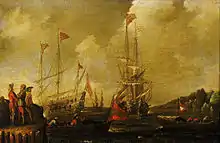Sebastian Castro (painter)
Sebastian Castro or Sebastianus a Castro was a Flemish painter specialized in marine painting who was active in Antwerp between 1633 and 1656.

Life
There are very few details about Sebastian Castro's life and training. It is believed he was of Portuguese descent and a member of a family, which had escaped the persecution of Jews during the Portuguese Inquisition of the early 1600s.[1] He may have trained under Andries van Eertvelt, the leading Flemish marine painter of the first half of the 17th century but there is no evidence of this.[2]
Castro is first recorded as a Master in the Antwerp Guild of Saint Luke in 1633–34. In 1656 he was still in Antwerp when he was registered as present at the distribution of the moveable assets of the father of the painters Gaspar van Eyck and Nicolaes van Eyck.[3]
Sebastian Castro was possibly the father of Laureys a Castro (also known as Laureys Castro, Laureys A. Castro or Lorenzo A. Castro), a marine painter who was recorded as a master in the Antwerp Guild of Saint Luke in 1664-65 and was later active in England.[1]
Work

Castro was active in Antwerp as a marine painter. The few works by his hand that are currently known cover the range of subjects typical for marine painters in the 17th century such as sailing ships, port scenes and naval battles. These works show an influence by the Dutch development towards tonal painting while retaining typically Flemish stylistic elements. This is demonstrated in the Spanish Ships at Anchor (National Maritime Museum, Greenwich) which through the tonality of its colour scheme, low horizon and build-up of clouds in the background reveals a Dutch influence while its more theatrical lighting and schematic depiction of the ships show a typically 'Flemish' style.[4]
His Harbour Scene, Spanish Ships Approaching a Jetty (National Maritime Museum, Greenwich) again show a tonality of colour and low perspective. The painting shows Castro's skill in depicting figures and boats in a landscape setting without sacrificing an overall painterly effect. The brushwork of the work is open and fluid.[5]
References
- About Laureys A. Castro at Jean Moust
- Andreas van Eertvelt, "Embarkation of Spanish Troops" at the National Maritime Museum
- Sebastian Castro at the Netherlands Institute for Art History (in Dutch)
- Sebastian Castro, "Spanish Ships at Anchor" at the National Maritime Museum
- Sebastian Castro, "Harbour Scene, Spanish Ships Approaching a Jetty" at the National Maritime Museum
| Wikimedia Commons has media related to Sebastian Castro. |